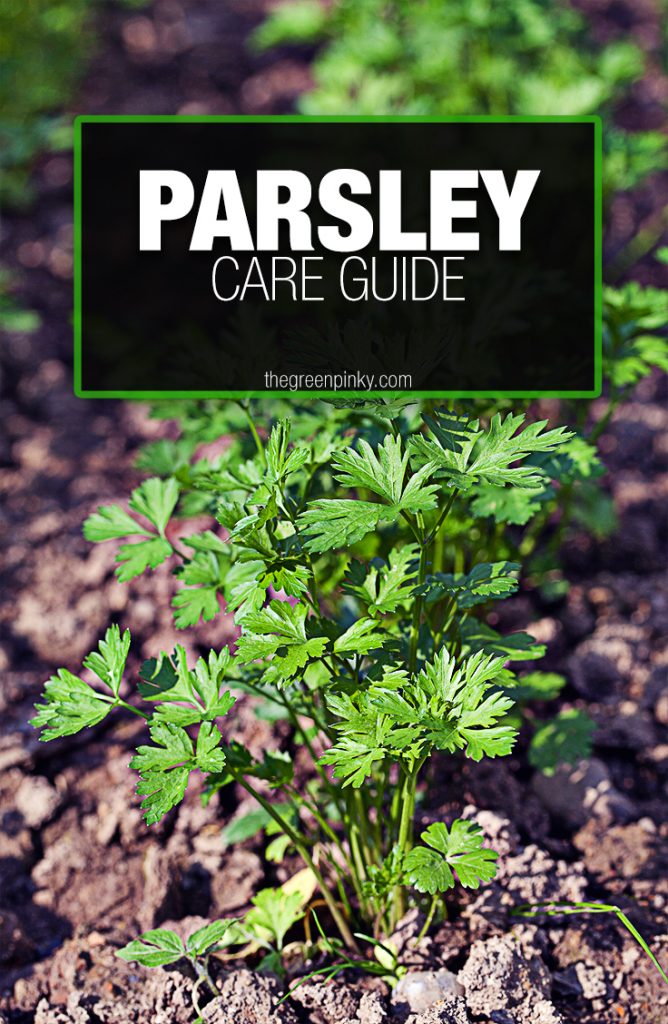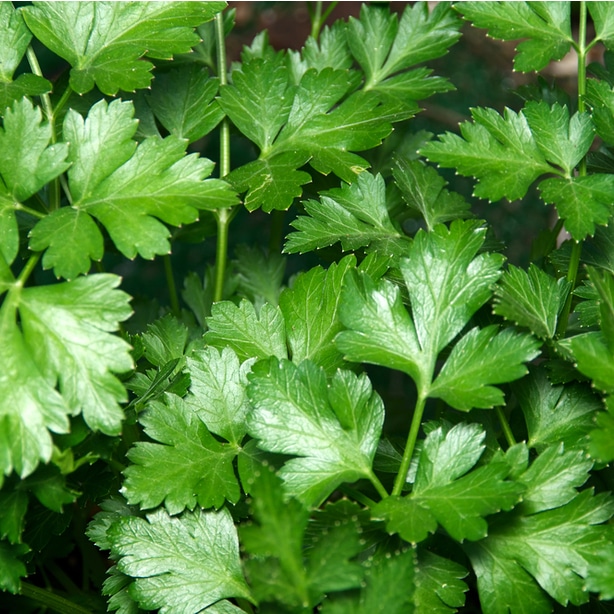At one time in our lives, many of us have been sitting at a restaurant, only to be brought a dish with a sprig of green adorning the plate. This, my friends, is parsley! While it plays a seemingly unnecessary role in diner fare, it’s actually an important culinary herb.
Parsley is considered an intermediate-level plant to grow because of its stubbornness when it comes to germinating. Once growing, though, it’s reasonably low-maintenance, tolerant of light frost, and thrives when grown next to many typical garden plants.

General information
Although a biennial herb, most gardeners in USDA growing zones 5 to 9 grow parsley as an annual plant. The seeds are very slow to germinate — a well-known complaint — and can take upwards of 5 to 6 weeks before they sprout. Once plants germinate, they take 70 to 90 days to mature before they are ready to harvest.
Types of Parsley
There are two types of parsley grown, curly leaf and flat-leaf. Curly leaf, Petroselinum crispum, is the variety commonly used for garnish. It has finely divided leaves with ruffled margins; plants grow 8 to 12 inches tall. Flat-leaf, Petroselinum crispumneapolitanum, has flat, vibrant green leaves. Also known as French or Italian parsley, it grows 18 to 24-inches tall.

Timing
Parsley, a cool-season crop, prefers the cooler, milder climates of spring and fall. Seeds germinate after the soil reaches 50 to 55 °F, with optimum germination between 65 and 70 °F. Plants bolt when air temperatures climb above 85 °F. Due to this, plant seeds in the early spring or the late summer.
- For colder climates:
- Start seeds indoors approximately four to six weeks before the last frost date for the area; transplant into the garden after the last frost-free date.
- Direct sow seeds in the spring at the last expected frost, once soil temperatures are above 50 °F. Plants can tolerate a light frost.
- Direct sow seeds four to eight weeks before the first expected autumn frost.
- For areas with moderate climates year-round, direct sow seeds whenever the air temperatures are above 50 °F.
Soil Preparation
With a taproot that grows deep down into the soil, parsley likes loose, well-drained soil full of nutrients. Till the ground well to a depth of 12 to 18-inches, breaking up clods and working two to three inches of compost or well-aged manure into the soil. The organic matter provided soil nutrients and improved drainage.
Planting
When temperatures are appropriate, direct sow seeds or transplant seedlings into the garden bed. Sow seeds about ¼-inch deep, and cover with a thin layer of soil. Space both seeds and transplants 6 to 8 inches apart within rows, leaving about 12 inches between rows. Seeds can always be planted closer and thinned when seedlings develop true leaves.

Care Guide
To be honest, experienced gardeners tend to shy away from growing parsley from seed because of its long germination period. Plants, however, are considered relatively easy to care for and do well in the garden if they receive enough sunlight, the soil is watered regularly, and you feed them periodic doses of weak fertilizer.
Sunlight
Plants are slightly more forgiving than some herbs about their sun exposure. They grow best in either full sun or part shade spots in the garden and prefer areas where they receive shade in the afternoon. This shade cools the air and soil temperatures during the intense part of the day, preventing bolting.
Watering
Parsley likes moist soil but doesn’t enjoy soggy conditions. Water plants after the top one to two inches of soil dries out, thoroughly saturating the ground. Sandy soils need water more often than silt or loam since they drain quickly. Avoid getting water on the foliage by watering the soil around the base of the plant.
Fertilizer Requirements
Compared to growing vegetables, herbs need a slightly different fertilizer regime. You want to give them enough “food” for their basic internal processes without encouraging an abundance of vegetative growth. Too much green growth reduces the flavor. Once plants reach 2 inches tall, apply a balanced, water-soluble fertilizer mixed at half strength every other week.
Weed Management
Herbs quickly show a negative growth response when they compete with neighboring weeds for water, sunlight, and nutrients. As chemical herbicides easily damage them, skip spraying weeds and instead remove them by hand or apply mulch to the garden soil to prevent weed seeds from sprouting. Weed control is essential when plants are young.
Pest & Disease Management
Parsley seems to have little problems with bacterial or fungal diseases, but it does have some insect problems you need to watch for. Whitefly, spider mites, and aphids — all common garden pests — will infest plants if you have an outbreak in other areas of the garden. Check the undersides of leaves often and treat with insecticidal soap if observed.
Harvesting
Deemed a “cut and come again” plant, you can frequently harvest foliage without killing the plant when done correctly. There is no need to wait until plants are fully mature. Once stems have three sets of leaves, you can cut or pinch off outer branches at their base. Do not harvest more than half the plant.

Growing Tips
Growing herbs indoors is relatively straightforward, making them a popular choice with people just starting to grow plants. In my opinion, it’s just as simple, if not more so, to have them outdoors in your garden. Especially if you heed the following tips. Some help to improve yields and others are just interesting growing “tricks.”
- If sowing seeds, soak them for 24 hours in water before planting to speed up germination.
- Grow one or two plants for fresh herbage and two to four for preserving the foliage.
- Sow seeds in containers, and grow indoors for a supply of fresh herbs when it’s too cold to grow plants outside.
- When actively growing, pinch or cut the tops off to encourage fuller, “bushy” plant growth.
- Plant extra to feed the parsleyworm caterpillar in late summer and fall, which turns into the prized black swallowtail butterfly.

Companion Plants
Herbs make great companion plants in the garden because of their natural aroma and flavorful foliage. Their aromatic nature tends to act as a natural pest repellent, protecting neighbors from insect problems. Parsley also encourages certain beneficial insects that prey upon harmful species. There are many plants it grows well with, and a couple you should avoid.
Some of the best companion plants include:
- Apples
- Asparagus
- Beans
- Brassicas
- Corn
- Pears
- Peas
- Peppers
- Radish
- Rosemary
- Roses
- Tomatoes
Avoid growing it with closely-related plants such as carrots, celery, and parsnips to avoid the chance of cross-pollination. Do not plant parsley near alliums (onion, garlic, chives) or lettuce.


